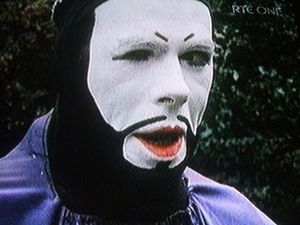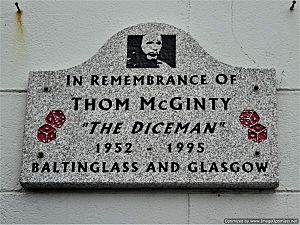Thom McGinty
Quick facts for kids
Thom McGinty
|
|
|---|---|

McGinty as The Diceman
|
|
| Born |
Thomas McGinty
1 April 1952 |
| Died | 20 February 1995 (aged 42) |
| Cause of death | Complications of AIDS |
| Nationality | Scottish-Irish |
| Other names | The Diceman |
| Occupation | Actor, model, street artist |
| Years active | 1976–1995 |
Thomas McGinty (born April 1, 1952 – died February 20, 1995), known as The Diceman, was a Scottish-Irish actor, model, and street artist. He was especially good at mime, which is a type of silent acting. Thom McGinty was born in Scotland, but his parents were from Ireland. He spent most of his life and career in Ireland. There, he became famous for acting like a living statue and was one of the country's most loved street performers. He also appeared in plays and movies. Thom McGinty passed away in 1995 when he was 42 years old.
Contents
Life and Work
Early Years and Moving to Ireland
Thomas McGinty was born near Glasgow, Scotland, on April 1, 1952. His parents, Thomas and Mary McGinty, had both lived in Ireland before. Thom was Scottish-Irish because his mother was born in Baltinglass, County Wicklow, Ireland. This meant he could also be an Irish citizen. He had one brother and two sisters. Every summer, his family would visit his mother's hometown in Ireland for holidays.
Thom thought about becoming a priest when he was younger. Instead, he studied accounting at Strathclyde University. But he decided to leave university early. In the early 1970s, he was part of the Strathclyde Theatre Group. Then, in 1976, he moved to Ireland. He started working as a model at the National College of Art and Design.
Becoming The Diceman
Thom McGinty got his famous name, "The Diceman," from one of his first jobs. He worked for a shop called The Diceman Games Shop in Dublin. This shop was first on Grafton Street and then on South Anne Street.
The Diceman became known for standing very still on the street. He would wear amazing costumes and stay completely silent for a long time. He was like a living statue. If someone put money near him, he would give a special, slow, playful wink. This was his trademark move. Sometimes, the police would ask him to move because too many people stopped to watch him. So, Thom learned to walk in extremely slow motion. It looked like he was moving, but he was almost standing still.
His costumes were often bright and imaginative. He dressed up as many different things. These included the Mona Lisa painting, Dracula, a light bulb, a teapot, or a clown. Thom called himself a "stillness artist" and a "human statue."
Famous Street Performances
Thom's first public shows in Dublin were as the "Dandelion Clown." He performed at the Dandelion Market, which was a creative market near St. Stephen's Green. In the 1980s and early 1990s, he became very popular. He performed on Grafton Street to advertise the Diceman shop.
When that shop closed, other businesses hired him. He advertised places like Bewley's café. He also used his performances to support important causes. For example, he supported human rights in Tibet. For a while in the early 1980s, he lived in County Galway. There, he started his own group called The Dandelion Theatre Company.
Acting and Media Appearances
In 1989, Thom McGinty acted in a play called Salome by Oscar Wilde. This play was shown at the Gate Theatre in Dublin. It then traveled to the Edinburgh Festival and to South Carolina in the USA. Thom also performed in The Maids by Jean Genet. He worked as an artist in many other countries, including France, Holland, Germany, Russia, Spain, and Switzerland.
He also appeared in two films: The Metal Man (1989) and Corkscrew (1990). Thom was a guest on a popular Irish TV talk show, The Late Late Show, twice. He was on the show in the mid-1980s and again in 1994.
Even though he was from Glasgow, Thom McGinty was seen as an honorary Dubliner. Hot Press magazine called him "Ireland's most famous street performer." They said he was a key part of Grafton Street life for over ten years. The Irish Independent newspaper called McGinty a "Dublin institution."
Remembering The Diceman
Thom McGinty passed away on February 20, 1995, at the age of 42. His friends carried his coffin down Grafton Street. A large crowd watched, and people clapped for a long time.
In 1997, the Lord Mayor of Dublin, Brendan Lynch, named a part of Meeting House Square in Temple Bar "The Diceman's Corner." A special plaque is there to remember him. In May 2001, there was an exhibition of twenty of his most creative costumes. These costumes were made by Aidan Bradley and Kathy Kavanagh/Showtime.ie. The exhibition was held during a music festival at Dublin Castle.
Two poems were written about Thom McGinty in 2002. One was called "Diceman" by Liam O'Meara. The other was the title poem of Paula Meehan's collection, "Dharmakaya."
become a still pool
in the anarchic flow, the street's
unceasing carnival
of haunted and redeemed.—Paula Meehan, Dharmakaya, for Thom McGinty
The poet Brendan Kennelly also wrote a tribute to Thom McGinty. He said that Thom's magic was in how he could make people stop and watch him. He could take them away from their busy city lives into a place of stillness. Actor Alan Stanford suggested in 2005 that there should be a statue of The Diceman on Grafton Street. A song called "Diceman" was released by Rocky de Valera and the Gravediggers in 2007.
More plaques remember Thom McGinty. One was put up in Baltinglass in 2010. Another is in Tralee, on Denny Street, where he used to perform during the Rose of Tralee festival.


